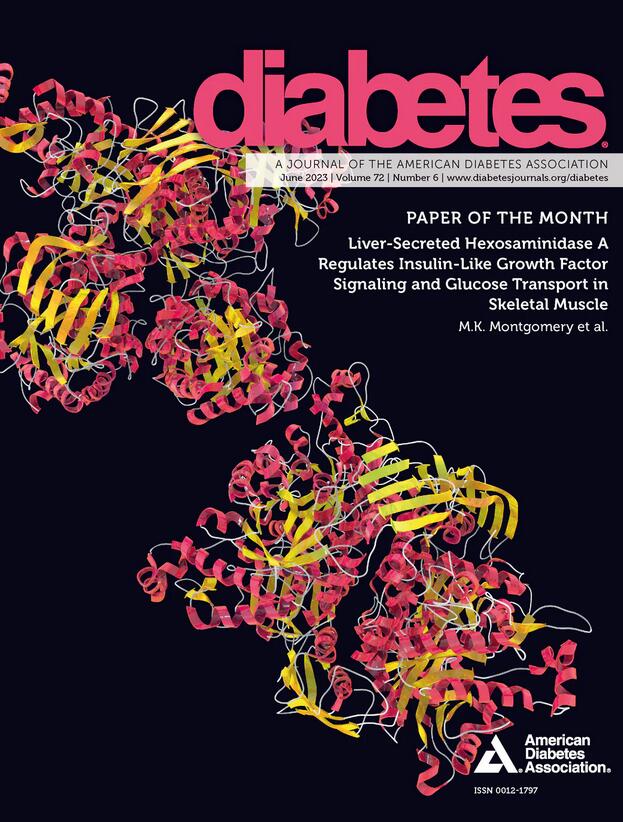激活 HPA 轴不能解释 2 型糖尿病患者对 GLP-1R 激动剂治疗无反应的原因
IF 6.2
1区 医学
Q1 ENDOCRINOLOGY & METABOLISM
引用次数: 0
摘要
胰高血糖素样肽 1 受体(GLP-1R)激动剂无法减轻相当一部分 2 型糖尿病患者的体重并改善血糖控制。我们假设,GLP-1R 激动剂刺激下丘脑-垂体-肾上腺(HPA)轴,从而诱导皮质醇分泌,这可能是对 GLP-1R 激动剂无反应的原因。为了评估GLP-1R激动剂治疗对HPA轴的影响,我们选择了10名(5名女性/5名男性)和9名(4名女性/5名男性)对GLP-1R激动剂无充分反应的2型糖尿病患者,并使用[68Ga]Ga-NODAGA-exendin-4正电子发射断层扫描(PET)/计算机断层扫描(CT)来量化垂体中GLP-1R的表达。对所有参与者的口服葡萄糖耐量和 24 小时尿皮质醇排泄量进行了测量。所有参与者均观察到垂体示踪剂摄取,有反应者和无反应者之间无明显差异。垂体示踪剂摄取量与促肾上腺皮质激素曲线下面积、尿皮质醇与肌酐比率和年龄相关。有趣的是,男性的垂体示踪剂摄取量高于女性。总之,这项研究并未表明垂体 GLP-1R 表达和 HPA 轴刺激在解释 2 型糖尿病患者对 GLP-1R 激动剂的治疗反应差异方面的作用。垂体 GLP-1R 的大量表达和显著的性别差异需要进一步研究。本文章由计算机程序翻译,如有差异,请以英文原文为准。
Activation of the HPA axis does not explain non-responsiveness to GLP-1R agonist treatment in individuals with type 2 diabetes
Glucagon-like peptide 1 receptor (GLP-1R) agonists fail to reduce weight and improve glucose control in a sizable minority of people with type 2 diabetes. We hypothesized that stimulation of the hypothalamic-pituitary-adrenal (HPA) axis by GLP-1R agonists, thus inducing cortisol secretion, could explain this unresponsiveness to GLP-1R agonists. To assess the effects of GLP-1R agonist treatment on the HPA axis, we selected ten individuals with type 2 diabetes with (5 women/5 men) and nine without (4 women/5 men) an adequate response to GLP-1R agonists and used [68Ga]Ga-NODAGA-exendin-4 positron emission tomography (PET)/computed tomography (CT) to quantify GLP-1R expression in the pituitary. Oral glucose tolerance and 24 h urinary cortisol excretion was measured in all participants. Pituitary tracer uptake was observed in all participants with no significant difference between responders and non-responders. Pituitary tracer uptake correlated with the area under the curve for ACTH, urinary cortisol to creatinine ratio and age. Interestingly, men had higher pituitary tracer uptake than women. In conclusion, this study does not indicate a role for pituitary GLP-1R expression and HPA axis stimulation to explain the difference in treatment response to GLP-1R agonists among individuals with type 2 diabetes. The findings of substantial pituitary GLP-1R expression and the significant sex differences require further research.
求助全文
通过发布文献求助,成功后即可免费获取论文全文。
去求助
来源期刊

Diabetes
医学-内分泌学与代谢
CiteScore
12.50
自引率
2.60%
发文量
1968
审稿时长
1 months
期刊介绍:
Diabetes is a scientific journal that publishes original research exploring the physiological and pathophysiological aspects of diabetes mellitus. We encourage submissions of manuscripts pertaining to laboratory, animal, or human research, covering a wide range of topics. Our primary focus is on investigative reports investigating various aspects such as the development and progression of diabetes, along with its associated complications. We also welcome studies delving into normal and pathological pancreatic islet function and intermediary metabolism, as well as exploring the mechanisms of drug and hormone action from a pharmacological perspective. Additionally, we encourage submissions that delve into the biochemical and molecular aspects of both normal and abnormal biological processes.
However, it is important to note that we do not publish studies relating to diabetes education or the application of accepted therapeutic and diagnostic approaches to patients with diabetes mellitus. Our aim is to provide a platform for research that contributes to advancing our understanding of the underlying mechanisms and processes of diabetes.
 求助内容:
求助内容: 应助结果提醒方式:
应助结果提醒方式:


